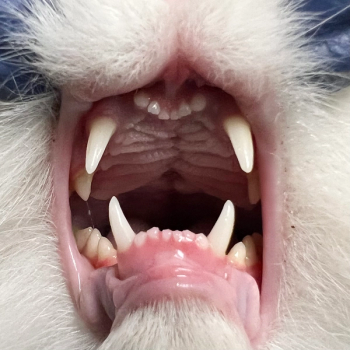
Delivering supplemental oxygen to dogs and cats: a practical review
Patients facing immediate, life-threatening conditions must have an inhaled oxygen concentration as high as possible. Eight additional methods are discussed in this second of two parts.
Patients facing immediate life-threatening conditions must have an inhaled oxygen concentration as high as possible.
Photos 1a : A nasal cannula is inserted and fixed in place by placing skin staples into the nose band made of adhesive tape. The oxygen tubing Y section "slides" snug behing the head.
In the first of this two-part discussion, we considered three methods of increasing inhaled oxygen concentrations to as high as 40 percent to 80 percent.
Now we will consider eight additional methods of delivering supplemental oxygen, including a new one that shows promise.
Photos1b: A nasal cannula is inserted and fixed in place by placing skin staples into the nose band made of adhesive tape. The oxygen tubing Y section "slides" snug behing the head.
Nasal cannula
This is a simple and rapid technique that involves the placement of a human nasal cannula that looks like two small prongs, each 0.5 cm to 1.5 cm in length, that are commercially available and inexpensive. They come in three sizes: infant, pediatric and adult (for animals > 5 kg, 5-15 kg, 16 kg and above, respectively).
A nose band is made from adhesive tape and skin-stapled on each side of the patient's face. The Y section of the oxygen tubing with the slide is tightened behind the head. (
It is a common technique used when it is anticipated that patients will need to be moved for radiographs, blood draws and require frequent monitoring.
Photo 2: A nasal catheter is placed and secured with a suture at the base of the nostril and several sutures or skin staples used to hold it to the side of the patient's face. A section of adhesive tape is used to secure the catheter and oxygen tubing as well.
Nasal catheter
Sedation is required in some cases to place the tube; this is very acceptable, and I often prefer it because it is less stressful for many patients (and the clinician).
Photo 3: Plastic wrap is laid over the ventral 50 percent to 80 percent of an Elizabethan collar and oxygen tubing attached on the inside. This Crowe collar is very effective in supplying supplemental oxygen to patients without using invasive means or causing isolation.
A few drops of proparicaine are placed into the nose, with the head mildly elevated. A suture is placed at the base of the nostril using either a swaged on needle or a 20-g needle and 3-0 section of nylon.
A 3.5 to 8 French-sized feeding tube is selected and lubricated with water-soluble jelly (4 percent lidocaine jelly works well). Premeasure the tube so the tip is at the first or second premolar. Insert the tube in a ventral and medial direction. Continue until the tube is placed at the predetermined level.
Now take the preplaced suture at the base of the nostril and go around the tube a few times and tie. Repeat this "friction" knot. Tape can be used as butterflies to hold the tube, but usually is not necessary.
Place tape around the neck to anchor the tube and attach the oxygen tubing (fluid administration set tubing can be used to deliver the oxygen, as in
Photo 4: Mask with a non-rebreathing system attached. This system also is fitted with a positive end-expirarory pressure (PEEP) valve or a restrictor assay valve.
Nasopharyngeal catheter
Placed similarly to the nasal catheter except the tip of the catheter is at the medial canthus of the eye or even further. It is important that the tip not be caudal to the leading edge of the soft palate.
Because oxygen flow is right at the pharyngeal vault region, a small amount of CPAP (continuous positive pressure ventilation) may be induced in a patient that closes its mouth or breathes with a certian amount of "grunt". This increases functional residual capacity in the lungs. It is indicated for acute treatment of any cause of severe pulmonary edema, such as that related to congestive heart failure, centroneurogenic, trauma and electrocution. Provide oxygen at 50-100 ml/kg/min. These can be placed in both nostrils.
Photo 5: Oxygen analyzer used to determine oxygen percentage inside a Crowe Collar being used on a cat with breathing difficulty.
Nasotracheal catheter
This is placed for oxygen delivery in patients with partial laryngeal paralysis or tracheal collapse but for whom placing a tube is risky, such as in head-injured patients. Placement is similar to nasal oxygen except the head is fully extended as the catheter is advanced past the level pharynx and into the trachea.
The larynx first is "sedated" with proparicaine by tipping the nose high at 90 degrees from horizontal and then multiple drops of proparicane given (three to six).
The nasal tube is then inserted rapidly into the pharynx as the patient takes a breath. Placement is confirmed by aspirating air easily from the tube. Coughing may or may not occur. Radiographs may be needed to confirm. Provide oxygen at 50 ml/kg/min.
Photo 6: Results of a research study comparing oxygen concentrations reached over time with various methods of oxygen delivery.
Transtracheal catheter
This is used if the nose has been injured, is bleeding or contains exudate, or if the animal has suffered a head injury and all the nasal–type catheters are contraindicated.
There are various ways that these can be placed. One is to place a small amount of buffered lidocaine on the midline of the ventral neck and, after a small nick is made in the skin as a relief incision, an appropriate length 14-18 g IV catheter is attached to a syringe.
It is guided through the skin nick and between two tracheal rings. Air is aspirated, indicating the catheter tip is in the tracheal lumen. The entire system is advanced slightly further inward and down the lumen and air aspirated again to insure the catheter is in the lumen.
The catheter is advanced off the needle and the needle removed.
Percent of oxygen achieved and time taken to reach noted levels
A T-port is attached to the tracheal catheter, and a light bandage is applied. An IV administration set can be attached and used to flow oxygen. A flow rate of 25-50 ml/kg usually is enough to raise concentrations above 60 percent.
Research shows this method will cause significant drying of tracheal membranes within four hours if no humidification is used, so it is recommended to add this as soon as possible to the administratrion system.
Crowe oxygen collar
This device can be used with a nasal catheter system or used alone as an alternative to nasal tubes for oxygen delivery.
An Elizabethan collar that is one size larger than would generally used is placed, and oxygen is delivered via a tube placed under the collar and taped to the ventral inside wall of the collar.
Plastic wrap is laid over the ventral 50 percent to 80 percent of the opening and taped in place (
A 2- to 4-liter flow rate generally supplies 50 percent to 60 percent oxygen in two to three minutes. If too much heat and moisture accumulate in the collar, higher flows can be used. In cats, a 1-liter flow rate generally provides 70 percent to 80 percent oxygen concentrations.
Oxygen cages
There is research to show that these devices are not very helpful in providing oxygen to patients in very acute conditions. Although many are used, it is important to remember that, once the patient is placed inside the cage, the patient is truly isolated from hands-on care. That is not so with the other systems. It also takes more than 20 to 30 minutes to get oxygen concentrations above 35 percent. Then when the cage door is opened to assess or manage the patient, the oxygen concentrations fall rapidly to room-air levels unless other supplemental methods are used.
The maximum concentration of >40 percent in these larger "containers" are not recommended by the National Fire Protection Association because there is significant risk of a flash fire in any oxygen concentrations above 50 percent. Even a spark caused by the rubbing of synthetic clothing can lead to a catastrophic fire.
Mask with non-rebreathing system attached (anesthetic circle) or new non-rebreathing system that shows much promise
This can be created by using a cone mask attached to either an anesthetic circle system that has a rebreathing bag and unidirectional valves (within the anesthetic system), or by attaching the cone to a new, commercially available, non-rebreathing system (Bruce Jones, Las Vegas, Nev.).
This system also can be fitted with either a positive end-expiratory pressure (PEEP) valve or a restrictor assay valve (
If one were just to connect a cone mask to a simple oxygen-supply source, without the unidirectional valves and reservoir bag, the system would be very inefficient, capable of achieving only up to 40 percent oxygen. During exhalation, carbon dioxide would become trapped in the mask, and during inhalation it would be rebreathed.
If the mask is fairly airtight, the speed of inhalation and the volume needed will surpass the volume within the mask and the work of breathing will be increased substantially,
Oxygen sensor
An oxygen sensor is a small photo-sensor that measures the amount of oxygen in the atmosphere. It is appropriate to use any time we are providing oxygen to our ICU patients so the oxygen concentrations being delivered can be known (
They are easy to calibrate and use. There are several available commercially.
Although high oxygen concentrations >80 percent are recommended in acute conditions, levels over 60 percent given for over 24 hours are associated with dysfunction of the type II cells that produce surfactant.
Without measuring oxygen concentrations one cannot know the effectiveness, nor the danger, of an oxygen supplementation system. It is recommended to monitor the percent of oxygen over time with each method of delivery.
This was done in one research study that compared oxygen concentrations reached over time with various methods (
In cases where cannula or catheters are used, the exhaled gas analyzed can be used to approximate the inhaled oxygen concentration. In these cases 4 percent is subtracted to estimate the inhaled concentration.
Crowe is chief of staff, Pet Emergency Clinics and Specialty Hospital, Thousand Oaks and Ventura, Calif. Call him at (706) 296-7020 or e-mail him at
Newsletter
From exam room tips to practice management insights, get trusted veterinary news delivered straight to your inbox—subscribe to dvm360.






